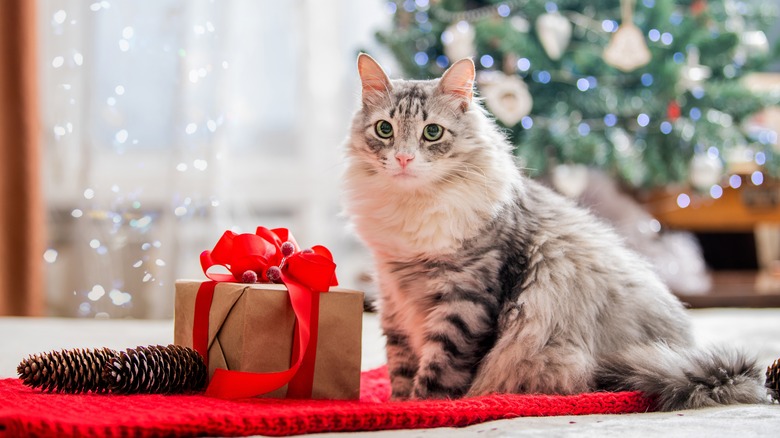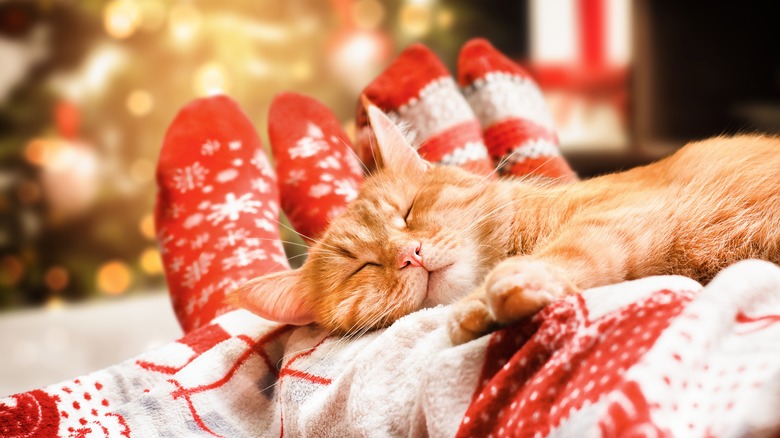The Myth Of Iceland's Yule Cat Explained
In the United States, most Christians will point to Santa Claus as the guy who embodies gift-giving and the message of the season. Of course, versions of Santa Claus predate the U.S. by centuries, but you can thank Clement Clarke Moore and his poem, "A Visit From Saint Nicholas," for the American version of the real Christian saint who became the embodiment of Christmas. Over in Europe, where most of the American Christian traditions began, there are Christmas figures who are adjacent to Santa Claus/Saint Nicholas (such as Father Christmas), there's Santa's evil henchman Krampus, and there are figures that bear no resemblance or connection to Santa at all, such as Italy's La Befana.
Over in Iceland, the tiny North Atlantic island nation of under half a million people, is a unique Christmas tradition: the Jólakötturinn, or Yule Cat. The myth combines two things: getting clothes for Christmas and being threatened with a gruesome death. Specifically, according to The Reykjavik Grapevine, the creature eats children who didn't receive new clothes for Christmas.
Europe, Christianity, Paganism, Iceland, And Yule
There's a lot to unpack here, so let's start at the beginning. Many of the Christmas traditions that American and European Christians love — various foods, decorations, even the date of the holiday itself — owe their origins to Europe and, in particular, at the hazy and sometimes-contentious intersection of paganism and Christianity. And one such pagan tradition that has been absorbed into the Christian holiday is Yule. As Cosmopolitan notes, Yule was/is the Germanic pagan festival of the mid-winter and never had anything to do with Christianity. That is, until the "new" religion came calling across Europe, and earlier pagan traditions began getting absorbed into Christian celebrations. To this day, the word "Yule" is synonymous with Christmas and the season ("make the yuletide gay," as the song says), even though, in the final analysis, they have nothing to do with each other save for adjacent places on the calendar.
Christianity reached Iceland around A.D. 1000 and, like other European peoples, combined their ancient pagan practices with their new, Christian beliefs. And one such tradition was and is yule, or "Jóladagur" in Icelandic.
Icelandic Christmas Traditions Are Unique
Before getting into a discussion of the Jólakötturinn, we should probably take a look at other Christmas traditions in Iceland to provide some context as to how and why the nation embraced a giant, child-eating Christmas cat.
Iceland is home to a Christmas tradition that is uniquely Icelandic: Grýla and Leppalúð, a troll giantess and her husband, respectively. As Guide to Iceland notes, Grýla is known for kidnapping miscreant children (and/or in some versions, adults) and cooking their flesh in a cauldron. And apparently, Icelandic children are terrified of her: "I remember how scared we Icelandic kids were of this terrible troll, Grýla — and she still gives me the creeps!" writes Regína Hrönn Ragnarsdóttir.
Grýla and Leppalúð are also the parents of the Yule Lads. According to Iceland Pro Travel, these 13 mischievous young boys leave small gifts in the shoes of good children. But if a child has been bad, they leave a rotten potato. It's within this context of a Christmas that includes quite a bit to dread and fear that the Icelanders came up with the evil Christmas cat.
Jólakötturinn, The Fashion Enforcer
The Jólakötturinn, unlike Krampus or Zwarte Piet, has a specific mission. He isn't concerned with children who are generally ill-behaved (and in turn either sees to it that they get nothing, or get something unwanted, or get beaten with sticks, or whatever). Rather, as Smithsonian notes, the Yule Cat is on the lookout for children who didn't receive new clothes before Christmas. And he shan't beat them or leave them a worthless bit of junk; rather, he eats them.
If you're wondering what on earth that's about, there are a few things to unpack here. First, although legend has it that Jólakötturinn has been an Icelandic, um, legend, for centuries, the reality is that written records of him only date to the 1800s, according to The Reykjavik Grapevine. And secondly, there's a morality tale in here: As Bored Panda reports, for centuries, Icelanders lived and died by wool production — which, as you are well aware, is crucial to the making of certain garments, particularly in colder regions. Because wool production involved the whole family, those who didn't get their chores done in time would be without woolen socks. So, in order to scare children into doing their chores, parents would threaten them with being eaten by an evil cat.
Today, the tradition has taken on a bit of a larger and more altruistic tone: As Mental Floss notes, the tradition also spurs on kids to be generous to the needy.



